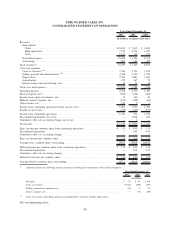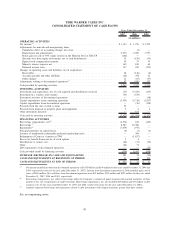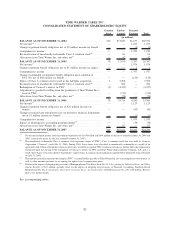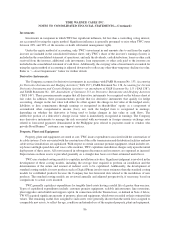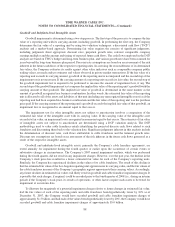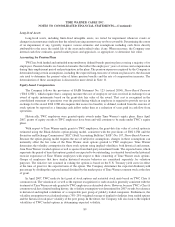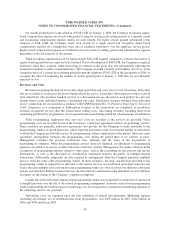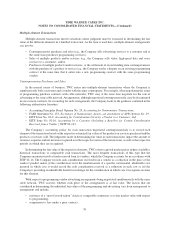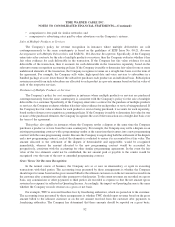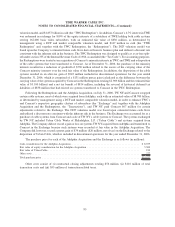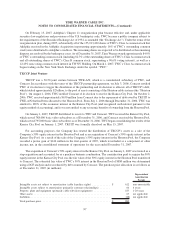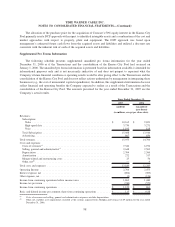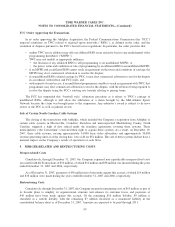Time Warner Cable 2007 Annual Report Download - page 95
Download and view the complete annual report
Please find page 95 of the 2007 Time Warner Cable annual report below. You can navigate through the pages in the report by either clicking on the pages listed below, or by using the keyword search tool below to find specific information within the annual report.For awards granted prior to the adoption of FAS 123R on January 1, 2006, the Company recognizes equity-
based compensation expense for awards with graded vesting by treating each vesting tranche as a separate award
and recognizing compensation expense ratably for each tranche. For equity awards granted subsequent to the
adoption of FAS 123R, the Company treats such awards as a single award and recognizes equity-based
compensation expense on a straight-line basis (net of estimated forfeitures) over the employee service period.
Equity-based compensation expense is recorded in costs of revenues or selling, general and administrative expense
depending on the job function of the grantee.
When recording compensation cost for equity awards, FAS 123R requires companies to estimate the number of
equity awards granted that are expected to be forfeited. Prior to the adoption of FAS 123R, the Company recognized
forfeitures when they occurred, rather than using an estimate at the grant date and subsequently adjusting the
estimated forfeitures to reflect actual forfeitures. The Company recorded a benefit of $2 million, net of tax, as the
cumulative effect of a change in accounting principle upon the adoption of FAS 123R in the first quarter of 2006, to
recognize the effect of estimating the number of awards granted prior to January 1, 2006 that are not ultimately
expected to vest.
Revenues and Costs
Revenues are principally derived from video, high-speed data and voice services and advertising. Subscriber
fees are recorded as revenues in the period during which the service is provided. Subscription revenues received
from subscribers who purchase bundled services at a discounted rate are allocated to each product in a pro-rata
manner based on the individual product’s determined fair value. Installation revenues obtained from subscriber
service connections are recognized in accordance with FASB Statement No. 51, Financial Reporting by Television
Cable Companies, as a component of Subscription revenues as the connections are completed, as installation
revenues recognized are less than the related direct selling costs. Advertising revenues, including those from
advertising purchased by programmers, are recognized in the period during which the advertisements are exhibited.
Video programming, high-speed data and voice costs are recorded as the services are provided. Video
programming costs are recorded based on the Company’s contractual agreements with its programming vendors.
These contracts are generally multi-year agreements that provide for the Company to make payments to the
programming vendors at agreed upon rates, which represent fair market value, based on the number of subscribers
to which the Company provides the service. If a programming contract expires prior to the parties’ entry into a new
agreement, management estimates the programming costs during the period there is no contract in place.
Management considers the previous contractual rates, inflation and the status of the negotiations in
determining its estimates. When the programming contract terms are finalized, an adjustment to programming
expense is recorded, if necessary, to reflect the terms of the new contract. Management also makes estimates in the
recognition of programming expense related to other items, such as the accounting for free periods and service
interruptions, as well as the allocation of consideration exchanged between the parties in multiple-element
transactions. Additionally, judgments are also required by management when the Company purchases multiple
services from the same cable programming vendor. In these scenarios, the total consideration provided to the
programming vendor is required to be allocated to the various services received based upon their respective fair
values. Because multiple services from the same programming vendor are often received over different contractual
periods and often have different contractual rates, the allocation of consideration to the individual services will have
an impact on the timing of the Company’s expense recognition.
Launch fees received by the Company from programming vendors are recognized as a reduction of expense on
a straight-line basis over the life of the related programming arrangement. Amounts received from programming
vendors representing the reimbursement of marketing costs are recognized as a reduction of marketing expenses as
the marketing services are provided.
Advertising costs are expensed upon the first exhibition of related advertisements. Marketing expense
(including advertising), net of reimbursements from programmers, was $499 million in 2007, $414 million in
2006 and $306 million in 2005.
90
TIME WARNER CABLE INC.
NOTES TO CONSOLIDATED FINANCIAL STATEMENTS—(Continued)


